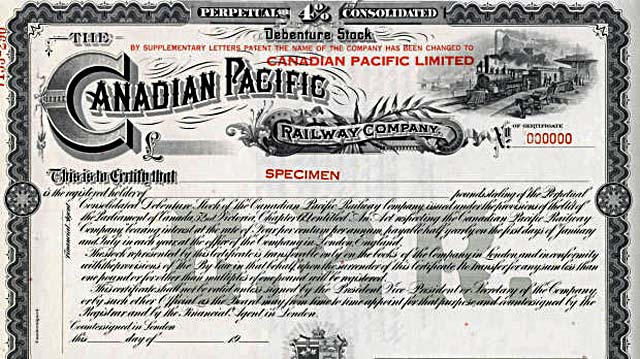
2012
|


Canadian Pacific Railway Consolidated Debenture Stock paying 4 percent - Date/Photographer unknown.
10 May 2012
Why CP's Old-Time Bondholders Have a Big Say in the Future
Toronto Ontario - Canadian Pacific Railway Ltd. has a problem over a century in the making.
As the company's war for control with activist investor Bill Ackman rages into its ninth month, obscure bonds issued just four years after the completion of
the trans-Canada railway are emerging as a potential financial hurdle to a restructuring of the company's balance sheet.
The bonds, which were sold as far back as 1889, are an investor's dream: Known as "perpetuals," they pay 4 percent interest rate annually every
year, have no date of maturity, and contain a clause that once required the company to make the interest payments in gold coins. What's more, the $31 million
of these bonds outstanding represent CP's highest-ranking debt, having first call on all its assets, ahead of all other bond issues, and carrying a credit
rating far above the rest of CP's debt.
But for CP, the bonds represent a big headache if the company ever attempts to reorganize its finances.
Any attempt to change the terms of the bonds could lead to legal claims that CP has to make the annual interest payments in their original form of
two-troy-ounce gold coins for every $1,000 face value of bonds.
To make the obstacle go away, experts say, CP may have to offer holders of the bonds a substantial premium to buy them out. "They are an oddity,"
said John Andrew, a Toronto lawyer who owns some of them and says that at current interest rates "they're not a bad investment at all."
That's if you can get a hold of them. With only about $31-million outstanding, they trade by appointment. Earlier this week, $6,000 worth changed hands around
$700 for each $1,000 face amount. Many of the bonds are held in relatively small amounts by holders in the U.S. Others have undoubtedly become lost or
misplaced over time.
"Some of these things are probably in the strong box on the Titanic in bearer form," Mr. Andrew says.
And holders aren't likely to feel gold coins jingling in their hands any time soon, the last payment of this kind was in 1933, because it would take some
serious legal missteps by CP to re-trigger the old gold clause.
When the bonds were issued, the U.S. was on the gold standard and bullion was valued at $20 an ounce, hence the two ounce payments a year. The U.S. abrogated
all gold clauses in the 1930s, when it made bullion ownership illegal, but then reversed its gold ban in the 1970s.
In the meantime, holders receive $40 a year in paper money for every $1,000 in bonds, which CP began issuing through an authorization by an act of Parliament
in 1889.
Not many people know about the bonds, whose existence the company mentions in passing on page 78 of its 2011 annual report, and explains in a brief one
sentence in note 20 (l) of its financial statements. The company has a second class of perpetuals denominated in British pounds, but these don't have the gold
clause.
The note says the bonds have "a first charge upon and over the whole of the undertaking, railways, works, rolling stock, plant property, and effects of
the company, with certain exceptions." That's the reason they sport a highly desirable double-A credit rating, compared to other bonds on the company's
books, which only rank in triple-B territory, one or three notches above junk.
All modern bonds have provisions allowing corporations to retire them, and for this reason CP would be able to modernize its balance sheet by getting rid of
the perpetuals. If they were gone, it would also allow the company to assign first call on its assets to a new debenture issue, possibly allowing it to borrow
at a lower interest rate. It would also have more flexibility in a takeover or merger.
But CP can't make any unilateral changes to the perpetuals without risking a claim by holders demanding it honour the original gold clause under a legal
concept known as novation, basically, replacing an old contract with a new one.
"I think the suggestion has generally been that a merger or similar reorganization could result in a new corporate entity and thereby constitute a
novation of the CDS (Consolidated Debenture Stock)", according to Mr. Andrew. He contends the existence of the bonds, and the hard-to-quantify threat
posed by the old gold clause, could make it difficult for the company to reorganize its balance sheet.
He says CP can eliminate the perpetuals only through a negotiated plan of arrangement with the holders, but that would likely require it to pay a premium above
current market prices to win enough support to retire the securities.
CP declined to respond to specific questions on the bonds, formally known as "consolidated debenture stock," but says they were issued between 1889
and 1937. "The CDS are not a material component of our debt structure. CP will buy the consolidated debenture stock, from time to time, as they are
offered to us," the company said.
Martin Mittelstaedt.

|
